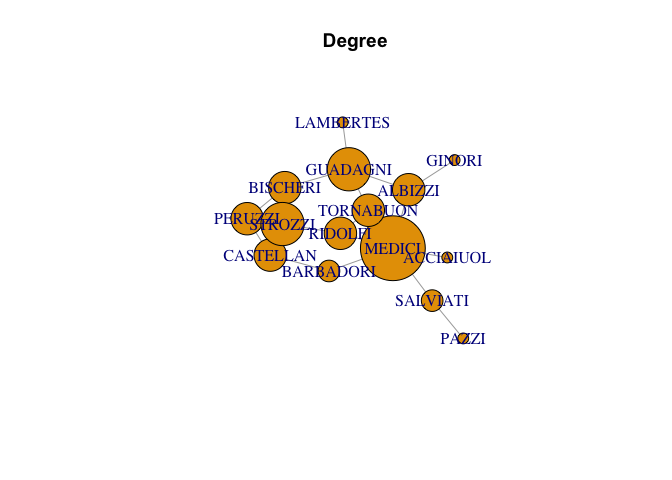a foray into network analysis
Posted onMarriage Networks of Florence
This post takes the example provided in Kosuke Imai’s Quantitative Social Science: An Introduction. It provides some exploration of network analysis through looking at the florentine dataset which counts the marraige relationships between several Florentine families in the 15th century. My historical side knows that our analysis should show that the [Medici Family] should appear at the center of all of the political intrigue. Let’s see if the analysis plays out.
Formatting the Data
The florentine data set comes as a dataframe. In order to work with
igraph it will need to be converted to a matrix with named columns and
rows. That conversion can be done here:
Starting Table
| FAMILY | ACCIAIUOL | ALBIZZI | BARBADORI | BISCHERI |
|---|---|---|---|---|
| ACCIAIUOL | 0 | 0 | 0 | 0 |
| ALBIZZI | 0 | 0 | 0 | 0 |
| BARBADORI | 0 | 0 | 0 | 0 |
| BISCHERI | 0 | 0 | 0 | 0 |
| CASTELLAN | 0 | 0 | 1 | 0 |
| GINORI | 0 | 1 | 0 | 0 |
| GUADAGNI | 0 | 1 | 0 | 1 |
| LAMBERTES | 0 | 0 | 0 | 0 |
| MEDICI | 1 | 1 | 1 | 0 |
| PAZZI | 0 | 0 | 0 | 0 |
| PERUZZI | 0 | 0 | 0 | 1 |
| PUCCI | 0 | 0 | 0 | 0 |
| RIDOLFI | 0 | 0 | 0 | 0 |
| SALVIATI | 0 | 0 | 0 | 0 |
| STROZZI | 0 | 0 | 0 | 1 |
| TORNABUON | 0 | 0 | 0 | 0 |
Now we need to manipulate the dataframe to turn it into a matrix object
so that we can pass it to the igraph package.
florentine_g <- florentine %>%
%>%
%>%
%>%
<- florentine %>%
Now we need to pass this object to igraph. The path is undirected
because there is no ordinality to this data. It does not encode if one
family proposed the marriage to the other group. If this were the case
then there could be some directedness to the graph. In this case there
isn’t so that is the parameter we will pass.
florentine_g <-
Now we can plot based on several features:
-
degree
-
closeness
-
betweeness
-
PageRank
Visualising the Network



The Numeric Outputs
floretine_networks <- %>%
| family | closeness | degree | betweeness |
|---|---|---|---|
| MEDICI | 0.0400000 | 6 | 47.500000 |
| RIDOLFI | 0.0357143 | 3 | 10.333333 |
| ALBIZZI | 0.0344828 | 3 | 19.333333 |
| TORNABUON | 0.0344828 | 3 | 8.333333 |
| GUADAGNI | 0.0333333 | 4 | 23.166667 |
| BARBADORI | 0.0312500 | 2 | 8.500000 |
| STROZZI | 0.0312500 | 4 | 9.333333 |
| BISCHERI | 0.0285714 | 3 | 9.500000 |
| CASTELLAN | 0.0277778 | 3 | 5.000000 |
| SALVIATI | 0.0277778 | 2 | 13.000000 |
| ACCIAIUOL | 0.0263158 | 1 | 0.000000 |
| PERUZZI | 0.0263158 | 3 | 2.000000 |
| GINORI | 0.0238095 | 1 | 0.000000 |
| LAMBERTES | 0.0232558 | 1 | 0.000000 |
| PAZZI | 0.0204082 | 1 | 0.000000 |
Additionally, the “pagerank” algorithm can be used.

Citation
BibTex citation:
@online{dewitt2018
author = {Michael E. DeWitt},
title = {a foray into network analysis},
date = 2018-09-17,
url = {https://michaeldewittjr.com/articles/2018-09-16-a-foray-into-network-analysis},
langid = {en}
}
For attribution, please cite this work as:
Michael E. DeWitt. 2018. "a foray into network analysis." September 17, 2018. https://michaeldewittjr.com/articles/2018-09-16-a-foray-into-network-analysis